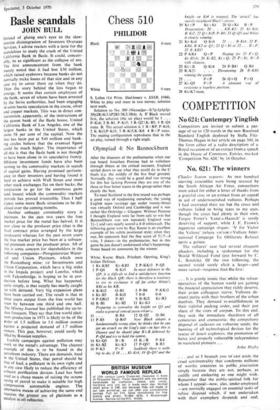Chess 510
PHILIDOR
S. Leites (1st Prize, Shakhmaty v. SSSR, 1946). White to play and mate in two moves; solution next week.
Solution to No. 509 (Niemeijer-8/7p/Iplp3p/ 3Pp2R/41c3/-1P2B3/51(2/3R4): A. If Black moved first, the solution (the set play) would be I. . . P-Kt4; 2 B-BI, P-Kt5; 3 R-Q2I,K-B5; 4 R-Q4 mate. B. The actual solution is 1 Bx RP, P-Kt4; 2 K-Kt3,P-K15; 3 R-Kt5,K-K6 4 R xP mate. The mating configuration reproduces that in the set play, turned through a right angle.
Olympiad 4: No Bannockburn
After the disasters of the preliminaries when our top board Jonathan Penrose had to withdraw through illness at the critical moment, England settled down to see what they could do in the C finals (i.e. the middle of the five final groups). Normally they would be a good deal too strong for this but lacking Penrose they are one of the three or four better teams in the group rather than clearly the best.
To meet Scotland in the first round was perhaps a good way of readjusting ourselves; the young English team (average age under twenty-three) was virtually Oxford and Cambridge and it was rather like Oxbridge v. Glasgow. Without Penrose I thought England were far from safe to win but Bannockburn was not repeated; England won 31-4 and very nearly scored a 4-0 whitewash. The following game won by Ray Keene is an excellent example of his subtle positional style; when they met, his opponent had the fine score of 51/7-4 wins, 3 draws—in the preliminaries, but in this game he just doesn't understand what's happening. Notes based on comments by the winner.
White, Keene. Black, Pritchett. Opening, King's Indian Defence.
1 Kt-KB3 Kt-KB3 2 P-KKt3 P-Q3
3 P-Q4 B-Kt5 In most defences to the QP, ills difficult to find a satisfactory function for the Black QB; there is therefore a tendency to try to exchange it off for either White's KICt or his. KB.
4 B-Kt2 Q-BI 5 P-B4 P-KKt3 6 Kt-B3 B-Kt2 7 0-0 0-0 8 P--QKt3 P-B3 9 B-Kt2 Kt-R3 10 R-B1 Kt-B2 11 Kt-KI . . .
Preparing to centralise the knight on Q3 and make a general central pawn advaPfe.
11 . . . B-R6 12 Q-Q2 Q-134
13 P-B3 Q-R4? Now Black adopts a fundamentally wrong plan; he thinks that he can get an attack on the king's side—in fact this is illusory and he should play Bx B followed by P-Q4 and try to hold the centre.
14 Kt-Q3 BxB 15 KxB P-K4 16 Kt-02 Kt-K3 17 P-Q5 I B-R3
18 P-K3 P x P Suddenly there is noth- ing to do; if 18 la-Kt4; 19 Q-QI! and the
knight on Kt4 is trapped. The 'attack' has merely misplaced Black's pieces.
19 KtxP KtxKt 20 QxKt BxP
Desperation; 20 . . KR-K!; 21 Kt-Kt4, B-Kt2; 22 Qx KtP, P-84; 23 Q-Q5 and White Is clearly winning.
21 Kt-Kt4 Q-Kt4 21 . . . B-Kt4; 22 P- KR4. B-K2 or Ql; 23 Qx Kt or 22 . . . BxP; 23 R-KRI!
22 P-KR4 Q x P Hoping for 23 Px Q. Kt-B5ch; 24 K-R2, Kt x Q; 25 Px Kt, BxR with chances.
23 Kt xB Q-Kt4 24 P-B4 I Q-R4
25 R-K2! . . . Threatening 26 R-K RI
winning the queen.
25. . . PxP 26 QxQ PxQ
27 Kt-Q5 PxP 4 pleasant way of resigning a hopeless position.
28 Kt-K7 mate.






































 Previous page
Previous page